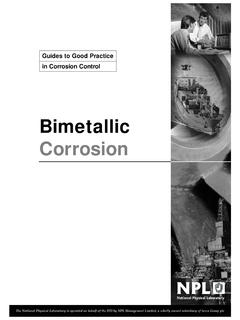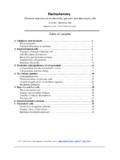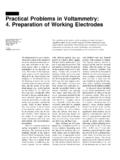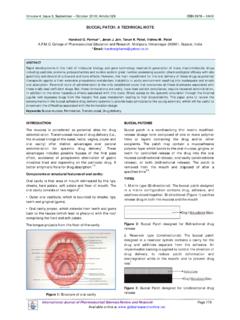Transcription of Capacitive Deionization: Challenges and Opportunities
1 | 34 | Desalination & Water Reuse | November-December 2013 TECHNOLOGY_____Lawrence Weinstein, FlexEl LLC Ranjan Dash, Dash & Associates LLC, USA___Editor s Note: When new technologies arrive on the scene, various companies and researchers publish their own particular view of their use and value. After a few years, some, like Capacitive deionization , achieve a toehold in the industry and are deserving of the more considered look these authors have given deionization (CDI), often called Capacitive desalination, electrochemical desalination or flow-through capacitor, is a fairly new desalination method. Over the past couple of decades, CDI has been promoted as a cheap, low-energy, high-yield competitor to reverse osmosis (RO) and electrodialysis (ED), with applications ranging from water softening to seawater desalination.
2 CDI electrochemically removes ions from salty water. A saltwater process stream flows between two electrodes held at a potential difference of around V. Ions in the solution are attracted to the oppositely charged electrodes. The ions are electrosorbed onto the electrodes, removing them from the process stream, and the deionization cycle continues until the electrodes are saturated with ions. Then, during the regeneration cycle, the two electrodes are discharged or the polarity of the electrodes is reversed. This releases the ions into a waste stream, which has a much higher salt concentration than the process stream. The major market advantage that CDI currently has over competing technologies is its ability to remove a wide range of ionic contaminants with high recovery rates.
3 CDI can remove nearly all ionic contaminants sulphates, nitrates, iron, arsenic and fluorides, along with sodium, calcium and magnesium salts. RO, which forces salty water through a nanoporous membrane, removes water from salt. By contrast, CDI removes salt from water. CDI has a much higher water recovery (up to 90% or more) than RO, which normally has a recovery rate of 50% or less. While CDI s high recovery rate is advantageous, it can also cause brine disposal issues. Brine injection back to source water can gradually increase total dissolved solids (TDS) in underground water, causing long-term environmental damage, which is a growing concern in developing countries such as India and Bangladesh. Meanwhile, CDI-based water softeners are being developed to compete with conventional resin technology, which, in contrast to CDI, requires the use and disposal of large amount of salty water, which can be environmentally unfriendly.
4 Unlike many, we believe that, at least in the short term, CDI will be used for low TDS applications (<5,000 ppm) and not for seawater desalination, due to high CDI unit costs, as discussed below, and the acceptability of low water-recovery in seawater usEDuring CDI s initial development, the potential for very high energy efficiency was seen as a major selling point. The more optimistic energy-use projections, however, require recovering energy during the regeneration cycle of operation; this requires a slow discharge to minimize losses due to polarization, and the electronics needed increase the cost and complexity of a CDI unit. Because fewer charge/discharge cycles can take place in a given time with energy recovery than without, the unit cost increases when using energy recovery.
5 No currently commercially available CDI system uses energy recovery. In fact, most CDI systems reverse polarity during the regeneration cycle, speeding up kinetics and increasing throughput while consuming additional ChaLLEngEThe major challenge for CDI is its cost both capital and operational costs are concerns. An RO system capable of treating 1,000 L/h costs between US$ 3,000 and US$ 4,000, whereas a similar capacity CDI system costs about US$ 10,000. It is possible for CDI units to be sold at a premium price over RO, primarily because of CDI s low life-cycle cost and its ability to remove a wide range of ionic contaminants with substantially higher water-recovery than RO. In the future, CDI may become more cost competitive. No components in CDI (apart from membranes) are expensive; today s high costs are due to Capacitive deionization : Challenges and Opportunities tEChnoLogyNovember-December 2013 | Desalination & Water Reuse | 35 |low manufacturing volumes and immature manufacturing processes.
6 SCaLing issuEElectrode scaling is one of the biggest issues encountered in CDI. Virtually all source waters contains calcium and magnesium ions, which are innocuous in concentrations normally seen but can create precipitates at high concentration. During operation, the negative electrode electrosorbs positive ions indiscriminately, including calcium and magnesium ions. When the unit is discharged, a buildup of magnesium and calcium compounds can form when high concentrations of magnesium and calcium are released. To date, mild acids (such as citric acid) have been the preferred descaling method; however, process monitoring to determine when to descale the unit adds to complexity. According to Idropan s CEO, Mariella Servida, CDI unit cleaning is a major technical challenge. Idropan claims to have solved this problem using a patent-pending microinjection system that injects a citric acid-based solution on a daily basis.
7 Other companies including AquaEWP and Enpar also have product literature and/or patent applications noting the use of citric acid to clean CDI anD mEmbRanEsHistorically, CDI has been touted as a membrane-free technology, and hence free from the issues facing membrane-bound processes such as RO and ED. Nonetheless, overcoming inefficiency and kinetic issues has generally required the use of membranes in practice. Marc Andelman of Biosource Inc first developed membrane CDI technology, and today most CDI units have ion-exchange (IX) membranes against their activated carbon electrodes to improve performance, while increasing cost. The IX membranes allow only positive ions to pass through to the negatively charged electrode, and only negative ions to pass through to the positively charged electrode.
8 This solves two major problems: slow kinetics, and inefficiency due to counterion desorption with increased cost and decreased desorption refers to the expulsion of ions with the same sign as the electrode. When the electrodes are at the same potential, they have ions of both charges (positive and negative) adsorbed on their surface. Upon charging they expel same-charged ions (counterions) and attract oppositely charged ions. For instance, the positive electrode expels positive ions and attracts negative ions. This causes a net transfer of positive ions to the negative electrode, and negative ions to the positive electrode, independent of the deionization , reducing efficiency. With membranes in place, the need to maintain electroneutrality necessitates that ions from solution cross the membrane to balance out the counterions, so that counterion desorption no longer causes transfer membranes also dramatically improve device kinetics.
9 When a CDI unit goes in the regeneration cycle without a membrane, it takes a relatively long time for the ions to diffuse out into the waste stream. With a membrane, the need to maintain electroneutrality at each electrode forces the ions to travel through the membrane quickly during the regeneration cycle, improving device the advantages of adding membranes, they are prone to fouling and degradation, and are expensive. While the continual charge transfer across the membrane is believed to help maintain the surface, prefiltration before the water reaches the CDI unit is necessary. Historically, ED units, which use ion-exchange membranes like those used for CDI, have had device lifetimes limited by membrane longevity. However, electrodialysis reversal (EDR), where the polarity of an ED system is periodically reversed, has shown improved longevity.
10 Since in CDI the polarity is reversed every cycle, this lends credibility to the idea that the membrane will be more robust than in ED. CDI units appear to decrease in water recovery over time due to engineering/design and membrane issues. It is believed that the space between electrodes increases with time, decreasing the flow resistance of water between the electrodes. This may be from the membrane wearing away during the repetitive charge and discharge cycling, pointing to the need for further membrane development work and improved device engineering. There are very few companies that manufacture membranes specifically for CDI; one notable company is Fujifilm s Netherlands operation. Little published research has focused on characterizing and improving membranes for CDI. CDI s reliability problems are design-related, and therefore can be solved as the technology matures.







